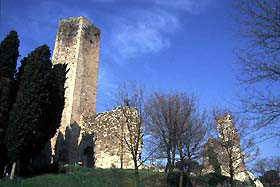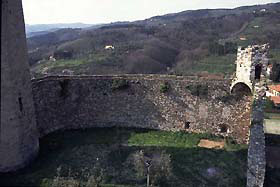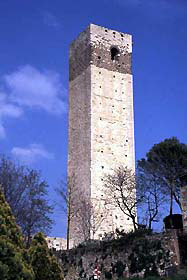Serravalle Pistoiese Castle
 |
 |
| The 'Rocca Nuova' (New Fortress) viewed form the outside and the inside. | |
The Castle of Serravalle can be reach following the highway Florence-Mare (A11) until the exit 'Pistoia' or 'Montecatini' (Serravalle is practically at half way between the two tollgates), then the indications up to the modern inhabited area of Serravalle Pistoiese. From here a road conducts under the rests of the New Fortress and of the other fortifications. Watch out because, even if signaled, the deviation can be easily passed without being seen.
Click for More Photos
Already the name of 'Serravalle' (close-valley) lets us understand what strategic position was occupied by the castle since its origin: at dominion of the forced passage that separate the valley of the Ombrone from the Valdinievole. From here, surely from to the Roman era, passed the main road of communication between Pistoia and Lucca, pursuance from Florence of the Cassia road. During the whole Middle Age this road maintained unchanged its importance making of the Serravalle castle, thanks to the presence of the two Fortifications, the Old one to southeast toward Pistoia and the New northwest toward the Valdinievole, the central stronghold of the whole defensive system of the area. The date of origin of the castle is not certain even if we know that in 1128 the fortified town already existed and was under Pistoiese control and that in 1148 the inhabitants of Serravalle, secretly allied with Lucca, tried without fortune to subtract themselves to this dominion. Between the 13th and the 14th century became frequently the wars against the near Montecatini for reasons for border, up to the peace signed in 1223. All the facts of these years interested the 'Rocca Vecchia' (Old Fortress), the only existing at the time.
 |
| The Barbarossa tower. |
In 1302 the Lucchesi, entered temporarily in possession of the castle, build, under the supervision of Uguccione della Faggiola, new fortifications on the Valdinievole side. These took the name of 'Rocca Nuova' (New Fortress). Well soon the new built powerful castle returned under control of Pistoia and became the general quarter of the famous commander Castruccio Castracani. In 1351 the castle passed in Florentine hands and, together with Larciano, became chief town of this territory inserted in the district of Pistoia.
The whole suburb was contained by an irregular wall circuit that chained the two fortresses. Of the most ancient, at the western vertex of the inhabited area, remains today only a magnificent tower with square plant called 'del Barbarossa', between the highest of the zone and recently restored, a second tower has become the bell tower of the church of Saint Stephen but unfortunately the strengthened enclosure has gone almost totally lost. On the opposite side of the relief risen the rests of the New Fortress. This still preserve great part of the mighty polygonal walls, a rectangular tower to the southwest angle and a characteristic hanging turret in that of northwest. This is united from a still intact curtain, in which can be still clearly identified the watch walk, to the stupendous hexagonal tower overlooking the castle side toward the Valdinievole, in which is opened the main external gate. Inside the inner ward is still visible the well for the water. All the complex is free opened to the public.
| More Photos |
| Back to Homepage |
| Back to Castles Index |